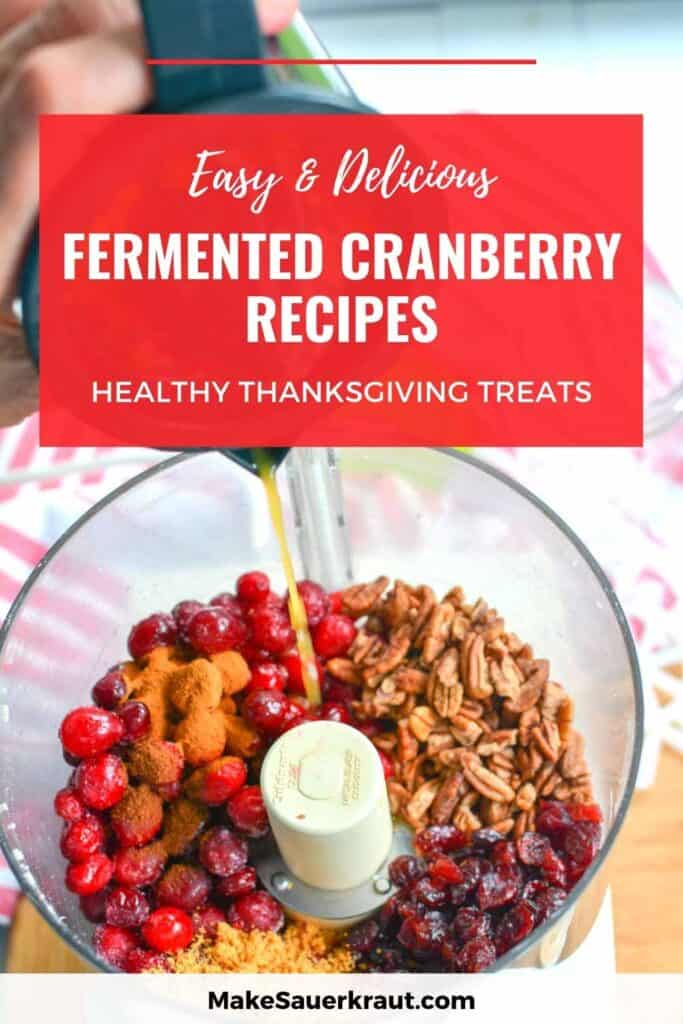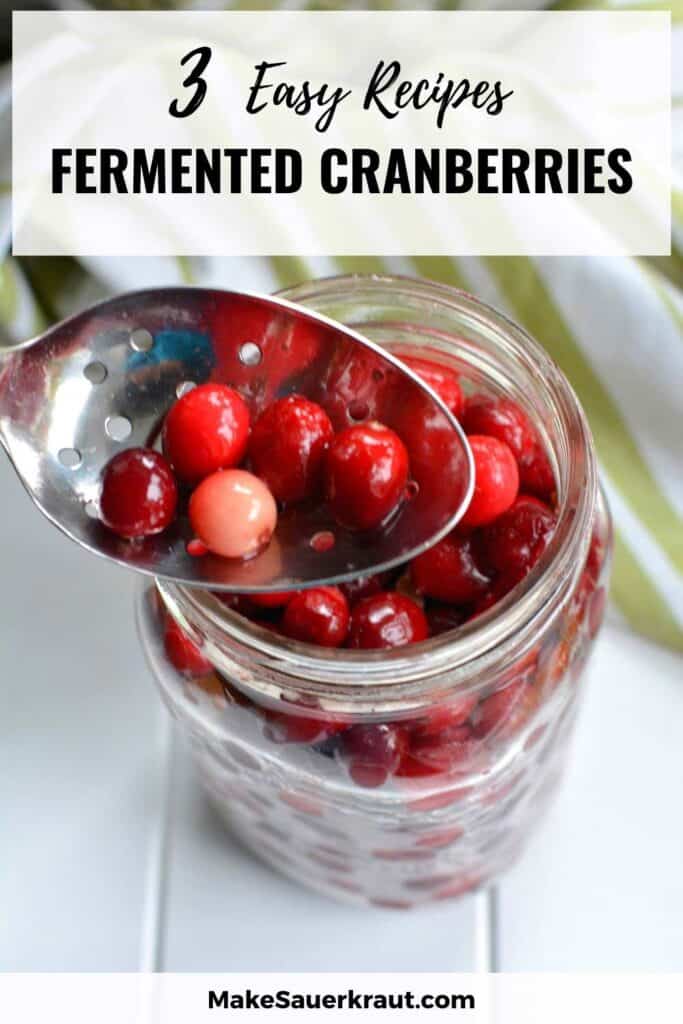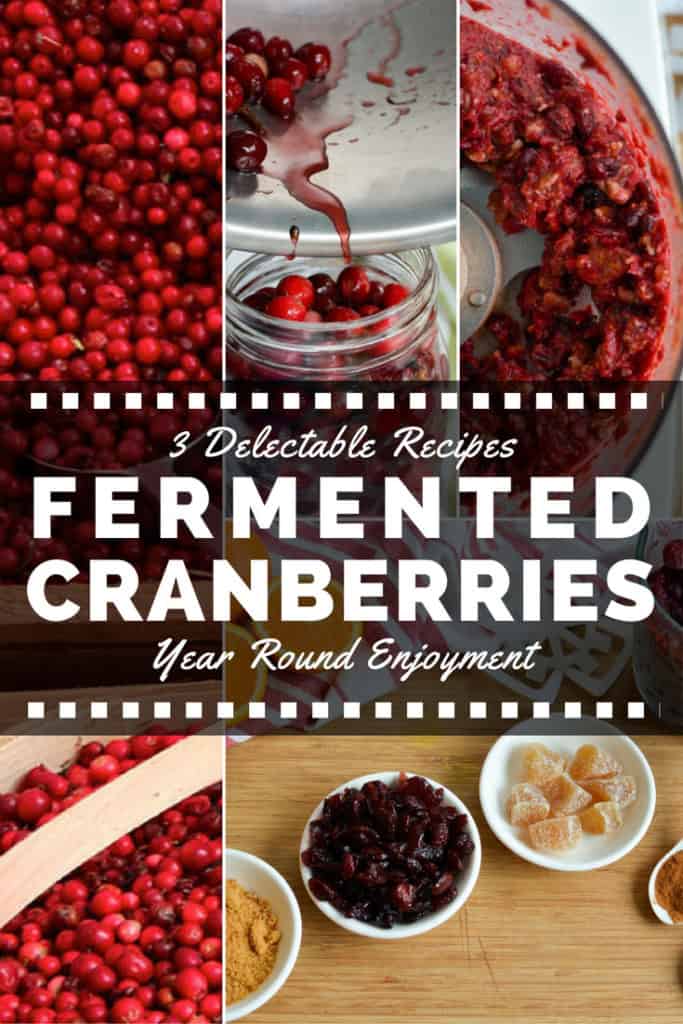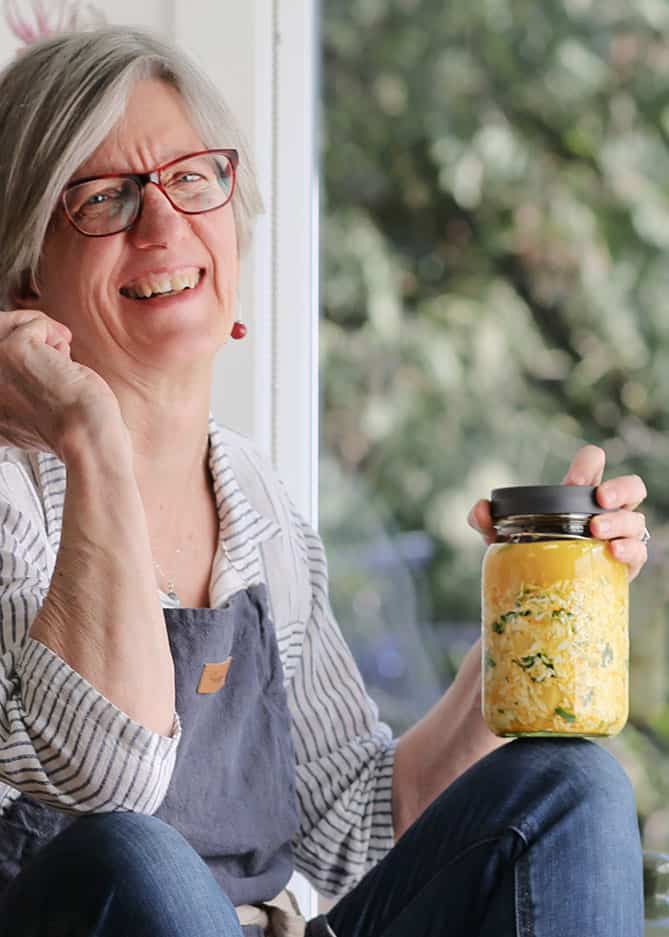In this recipe, fermentation transforms sour cranberries into three unique and flavorful ferments that become a novel way to enjoy cranberries year-round.
Cranberry-Orange Relish, with fresh cranberries, toasted pecans, and candied ginger is the perfect combination of sweet and tart. It goes great with soft cheese and crackers for a tantalizing and eye-catching appetizer. You can also use it for topping your yogurt, adding toasted coconut and a bit of maple syrup. And of course, it’s always colorful and delicious alongside turkey.
The Raw Cranberry-Apple Chutney has the goodness of raw cranberries, apples, onions and spices enhanced with live cultures that are created during fermentation. A few spoonfuls of this is always welcome as a flavorful afternoon snack.
Pickled Cranberries are not only a novel way to use cranberries, but they are extra fun to eat. Pop them in your mouth like candy for a burst of sour fizziness to tantalize your tastebuds. You will wow guests with these at any party.
When you hear the words “Cranberry Sauce”?
Or, “Cranberries”?
What first comes to mind for you?
Perhaps, the image of a sugary, sweet relish that you pop out of a can twice a year around Thanksgiving and Christmas???
If it’s loved by Bart, it will definitely make it’s way to your heart! #USCranberriesIN #CranberryRed pic.twitter.com/QidCW9K5zA
— US Cranberries India (@USCranberriesIN) October 23, 2017
I aim to change those images with the help of trillions of microscopic friends transforming sour cranberries into flavorful ferments that you can make now and then enjoy all year long. And, these fermented cranberry recipes don’t even come close to that canned stuff.
Since fermentation has entered my life, I’ve learned so many flavorful and healthy ways to ferment more than just sauerkraut: carrots, beets, coconut water, pickles, and even garlic!
The list continues and now includes fermented cranberries!
Who Knew?
Here on Vancouver Island, we’re lucky to have local cranberries. Yellow Point Cranberries, a family-owned and operated cranberry farm marks the seasons for me by their appearance each fall at my local farmer’s market.
Their stand displays a cornucopia of fresh cranberries for just a few short weeks. I grab a few bags and stash them in my freezer to put to good use in the ensuing months.
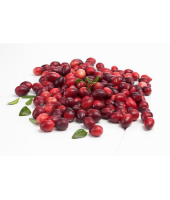
Americans eat 400 million pounds of cranberries per year. Consumption of cranberries is greatest during Thanksgiving week. Around 80 million tons of cranberries are consumed during that period.
All About Cranberries
Cranberries are often a part of a Thanksgiving celebration in the form of cranberry sauce served alongside turkey. But, there is much more to cranberries than a jellied mixture sold in a can.
Fun Facts About Cranberries
- Just a few fruits farmed in the United States are native. Cranberries are one of those fruits.
- Native Americans used a cranberry poultice on their arrow wounds because of its anti-inflammatory properties.
- One-fifth of America’s total harvest of cranberries is consumed around one day: Thanksgiving.
- Only five percent of cranberry crops are sold as fresh cranberries.
- New Jersey is one of the top three states in the United States that grows cranberries.
- The Lee Brothers, a 7th generation cranberry farm, has been growing cranberries since the mid-1800’s.

Cranberry juice was used as a source of vitamin C for the prevention of scurvy (disorder induced by vitamin C deficiency) on American ships in the past, as was sauerkraut.
How Do Cranberries Grow?
Under water? No.
But why do we always see them floating on water as in this picture that I just can’t pull my eyes away from?
Cranberries grow on low trailing vines in sunken beds called bogs. The plants are perennial meaning they survive year after year, some being 65 years old. They love sandy soil and take a long time to grow. 16 months!!!
Iconic northerness, wild cranberries growing on a bed of caribou lichen. #spectacularnwt pic.twitter.com/fzuUV6aOe3
— Laurie Sarkadi (@LaurieSarkadi) 16 September 2016
Water is an important and precious commodity for cranberry growers. Though the cranberries grow on dry land, water is used to flood them twice a year.
In December, farmers plug the bogs and flood them for the duration of winter. This is when the plants go dormant and this blanket of water insulates the vines from harsh winter frost.
In the spring, the bogs are drained and the cranberries bloom with fruit beginning to grow by mid-June shifting their colors from green until fall when they turn red. Now, cranberry bogs are flooded a second time for the October harvest.
Ever notice those air pockets inside a cranberry? That’s what makes them float once they are gently knocked off the vines to ready them for harvest. This floating ability will challenge you in the Pickled Cranberries recipe.
Did you know cranberries have four air pockets which allows them to float during harvest? #cranberry pic.twitter.com/pvlbBb9xF3
— Cranberry Fruit News (@TilbergBenjamin) 5 January 2016
More in the following How Does It Grow? Cranberries video.
Health Benefits
A quick look here at the benefits of cranberries. And guess what? Fermenting them will increase benefits and add nutrients making them just a tad more healthy. Though to reap the noted health benefits, you’ll need to eat quite a few cranberries or consume them in their more concentrated form as juice.
Cranberries are packed with Vitamin C, potassium and disease-fighting antioxidants. Cranberries have been shown to:
- Prevent the development of kidney stones.
Quinic acid, abundant in cranberries, may help prevent the development of kidney stones. - Protect against urinary tract infections.
Proanthocyanidins – antioxidants – found in cranberries appear to block the adhesive strands of the E. coli bacteria from sticking to a surface thus inhibiting their ability to stick to the walls of the uterus and bladder. - Reduce dental plaque.
It is believed that cranberry juice can control the overgrowth of bacteria that cause dental plaque.

Cranberries are a good source of dietary fibers, vitamin C and manganese.
How to Buy, Store and Prepare Cranberries
Cranberries are in season from mid-September until around mid-November in North America.
- Organic vs. Conventional?
What a rabbit hole this question has unearthed…According to the Organic Center’s “Dietary Risk Index,” which quantifies relative pesticide risks from specific foods by analyzing the U.S. Department of Agriculture pesticide residue data, domestically grown cranberries pose almost the greatest pesticide risk per serving of all conventionally grown fruits and vegetables. Only green beans pose a greater risk.Buyer beware.Buy organic whenever possible. Organic cranberry farmers rely on particularly timed flooding, hand-weeding or other labor-intensive techniques, and natural amendments to maintain their cranberries. And, to reduce pesticide load…Ferment your cranberries!
New science is finding that bacteria not only make fermentation happen but that they can also significantly reduce pesticide residues in food. One study looked at the role of microorganisms in the degradation of insecticides during the fermentation of kimchi. Another study looked at a breakdown of pesticide residue in wheat. - Choosing fresh berries.
A fresh cranberry will be shiny and plump and have a deep red color; the deeper the color the more highly concentrated the beneficial compounds are.According to The Spruce, “Truly fresh cranberries are quite firm to the touch and will bounce if you drop them. (Cranberry harvesters will actually bounce the berries against boards to sort the high quality from the low quality.)” Avoid shriveled berries or those with brown spots. Before buying, give the bag of cranberries a careful inspection to make sure there aren’t any soft or mushy berries or liquid hasn’t collected inside the bag. - Stock up seasonally and freeze.
Cranberries are sold fresh only from October through December. Cranberries tightly sealed in a plastic bag will keep for a month or two in your refrigerator or a year in your freezer.To improve the quality of your frozen berries, first slid your bag cranberries into a Ziplock freezer bag. Many stores have frozen cranberries available year-round. Fresh or frozen cranberries can be used in my recipes. - Discard any soft or shriveled berries.
To prepare your cranberries for fermentation, sort through them, discarding soft or shriveled berries. Depending on when they were picked, not all berries will be dark red, which is fine. I don’t rinse my berries, since the bacteria I want to make fermentation happen lives on the surface of the berries. - Cups vs. Ounces?
A 12-ounce bag of cranberries will yield about 3 cups of whole cranberries.

The fruit of a cranberry is the berry. Immature berries are white in color. Mature berries are red-colored.
The Five Tools I Grab Every Time I Ferment Something
Recipes for Fermented Cranberries
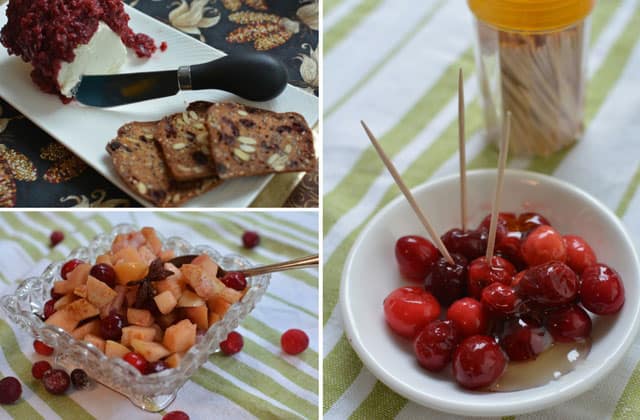
Clockwise from bottom left: Raw Cranberry-Apple Chutney. Cranberry-Orange Relish with goat cheese and crackers. Pickled Cranberries.
Cranberry-Orange Relish? Raw Cranberry-Apple Chutney? Pickled Cranberries?
Read through the recipes and choose one.
We’re all familiar with cranberry sauce, cranberry juice, and dried and sweetened cranberries but those sour red morsels can also be fermented.
When fermenting cranberries, it is fine to use them frozen. In fact, since I buy mine seasonally, it is the only way I use them. Watch for them to go on sale around Thanksgiving and Christmas and buy a few extra bags to have available when you want to try fermenting them.
In some of the recipes, I have you smash up the cranberries a bit to burst their skins. This can be done with a few quick pulses in a food processor or simply by mashing them with a potato masher. The skins don’t break easily, but as long as you get some of them cracked or popped, the fermentation process will proceed.
1. Cranberry-Orange Relish
Cranberry-Orange Relish is hands-down my favorite fermented cranberries recipe. I enjoy it year-round.
Cranberry-Orange Relish is fermented in its own juices, though you will not see as much brine rise to the surface as you do with sauerkraut.
The ingredients are chopped with salt, sugar, and seasonings and then mixed well. Using orange juice keeps the brine acidic to prevent spoilage until the lactic-acid bacteria establish a safe fermentation environment. Fermentation enhances the flavors and reduces the sugars.
I love to eat Cranberry-Orange Relish with a creamy cheese – goat cheese is a nice one – and crackers for a tantalizing and eye-catching appetizer.
I recently came up with a new favorite: A flavorful yogurt topping. Top a bowl of yogurt with a dollop of Cranberry-Orange Relish, a sprinkle of toasted coconut and a splash of maple syrup (if you want a bit more sweetness). It makes me hungry just talking about it.
A small spoonful of Cranberry-Orange Relish is also a great way to not only add depth to any meal but to also satisfy a craving for something sweet.
And of course, it’s always colorful and delicious alongside turkey.
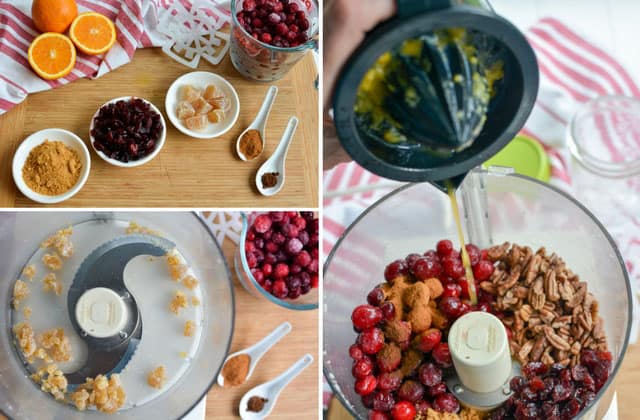
Clockwise from bottom left: Processing the candied ginger first to make sure it is cut small enough. Ingredients for Cranberry-Orange Relish. Pouring orange juice into the food processor.
I first chop the candied ginger because it can take a bit of work to get it cut into small bits. All the rest of the ingredients – cranberries, pecans, dried cranberries, ground cinnamon, ground cloves, sugar, orange (juice & zest) and salt – are then added.
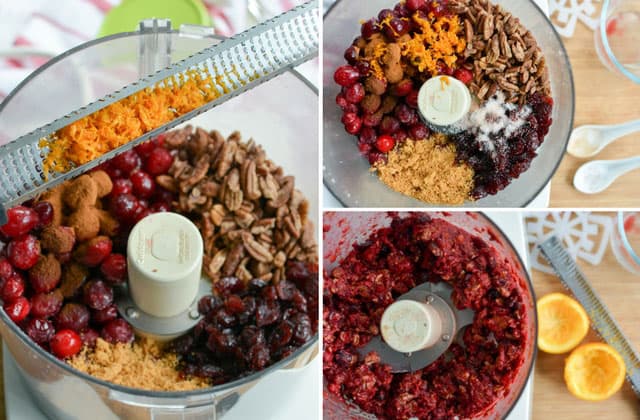
Clockwise from left: Adding orange zest to the rest of the Cranberry-Orange Relish ingredients in the food processor. Ready to pulse all ingredients. Coarsely pulsed relish.
Don’t forget the orange zest! Pulse to desired consistency. Here I’ve coarsely chopped the ingredients. You can chop a bit more if you’re wanting a smoother consistency.
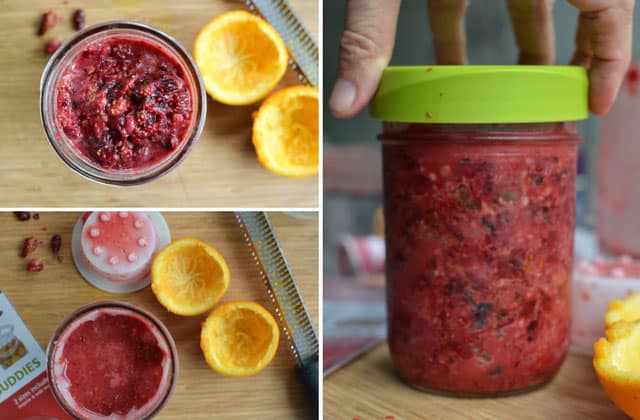
Clockwise from bottom left: Packed jar of relish with a Canning Buddies fermentation weight inserted into the neck of the jar to keep the ferment below the brine. Packed jar of relish without a fermentation weight. Lid screwed onto the packed jar of Cranberry-Orange Relish.
The relish then gets packed into a pint jar. I often have some leftover that just gets put into whatever jar I can find.
I don’t find it necessary to use a device to hold everything below the brine. I’ve noticed with many of my relishes and pastes that have higher levels of acidity and ferment for such a short period of time, that no mold grows on the surface. So if you don’t have a “weight” of some sort to hold everything below the brine, don’t worry.
In these images, though, I show the use of the ViscoDisc Canning Buddies which I reviewed here. If I’m going to use a “weight” for my paste ferments, I find myself grabbing either the PickleHelix or the Kraut Source Fermentation Lid as reviewed here. Its spring-loaded plate does a stellar jar of applying enough force to paste and relish ferments that brine is forced out and the ferment is held beneath this brine throughout fermentation.
With the PickleHelix you’ll need to place a piece of folded parchment paper on top of the packed ferment before inserting the coiled helix. This will prevent the relish from oozing up through the spring during fermentation.
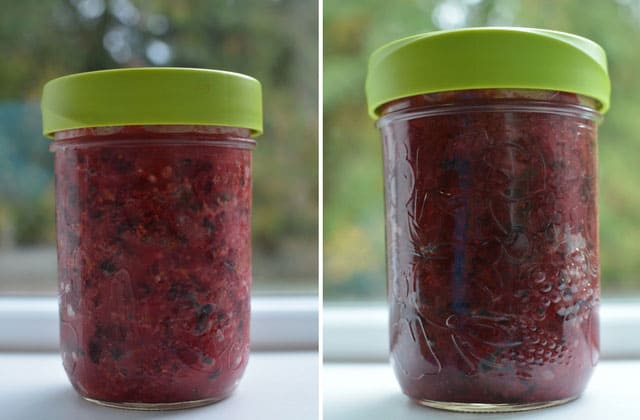
Left to right: A jar of freshly prepared Cranberry-Orange Relish. Relish after 5 days of fermentation; original bright colors have dulled.
Cranberry-Orange Relish Recipe
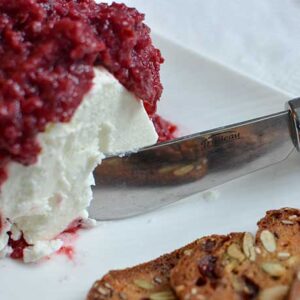
Cranberry-Orange Relish
EQUIPMENT
- 1 pint (500 ml) wide-mouth canning jar or similar sized jar & lid
- Optional weight and airlock device
- Food processor
INGREDIENTS
- 1/4 cup (60 ml) candied ginger
- 2 cups (480 ml) fresh or frozen cranberries, measured out; or 8 ounces (230) grams, if weighed
- 1/2 cup (120 ml) pecans, lightly toasted
- 1 orange, zest and juice of
- 1/2 cup (120 ml) dried cranberries
- 1 teaspoon (5 ml) ground cinnamon
- 1/2 teaspoon (2 ml) ground cloves
- 3 tablespoons (45 ml) sugar
- 2 teaspoons (10 ml) iodine-free salt (fine-grain)
INSTRUCTIONS
- CHOP.Use a food processor to first coarsely chop the candied ginger.
- ADD remaining ingredients and pulse until medium consistency. Taste and adjust seasonings, adding a bit more sugar if desired.
- PACK the cranberry mixture into a wide-mouth pint (500 ml) jar, pressing relish mixture down tightly with a large spoon or tapping the jar on the counter to jostle mixture down. Don't worry if there is no brine to cover the mixture.Leave 1 inch of headspace between the top of the cranberry relish and the top of the jar.Pack any excess relish into another jar.
- SUBMERGE.If using an optional weight, add it now. I have fermented this relish successfully both with and without weight and airlock. It's a thick paste and you may not see much of any brine.Firmly screw on lid with or without an airlock. Write the date and recipe name on the lid. Since this ferment does not produce excessive CO2, you're fine with just a regular lid.
- FERMENT.Place in a shallow bowl on your kitchen counter, out of direct sunlight to ferment for 5-7 days.As it ferments the color deepens to a dark red. You may see air pockets develop as CO2 gasses are created. No need to worry. Either leave it be or press down on the mixture with a fork to eliminate the air pockets.
- SAMPLE. Taste around the 5-day mark, looking for a sour tang with a bit of sweetness in the background. Ferment for a few more days, if necessary.
- STORE. When fermented to your liking, add the fermentation length to your label and place it in your refrigerator where it can last 6 months to one year.
- ENJOY. Cranberry-Orange Relish may be eaten alongside poultry. I especially love it with soft cheese (goat or brie) and crackers. It also works great as a topping for yogurt.
Notes and Tips
- Cranberries seem to be sold in 12-ounce (340 g) bags. A 12-ounce (340 g) bag of cranberries will yield about 3 cups of whole cranberries.
- Fresh or frozen cranberries work equally well in this recipe.

The name “cranberry” is a shorter version of the original name of the plant: “crane berry”. Dutch and German settlers coined this name because of the light pink flowers whose petals twist backward and together with the stem create the impression of the head, neck, and bill of a crane.
2. Raw Cranberry-Apple Chutney
This Raw Cranberry-Apple Chutney recipe does not call for a lot of cranberries, but it still makes a festive, probiotic-rich apple salad.
This recipe comes from KrautSource, the company that makes a pretty cool water-sealed fermentation lid for wide-mouth mason jars that I reviewed here.
Since the ingredients in this recipe don’t create their own brine, a brine is instead mixed and then poured over the mixture and left to ferment much like is done when fermenting carrots, beets or cucumbers for pickles.
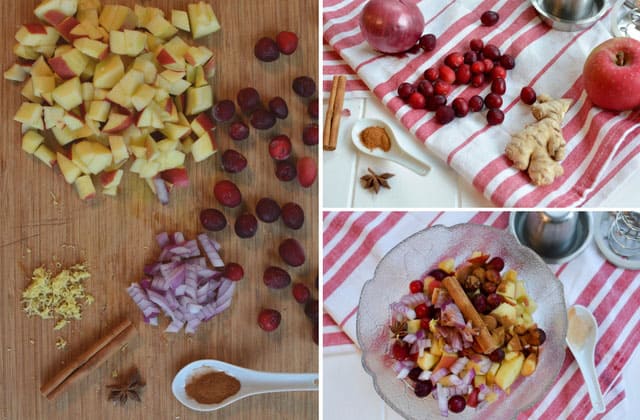
Clockwise from bottom left: Prepared ingredients for chutney. Apple, red onion, ginger, cranberries, and spices. Cranberry Apple Chutney ingredients are mixed and ready to pack into a jar.
I first gather and chop ingredients – apple, red onion, cranberries, ginger, cinnamon, star anise – and then place them in a small bowl for mixing.
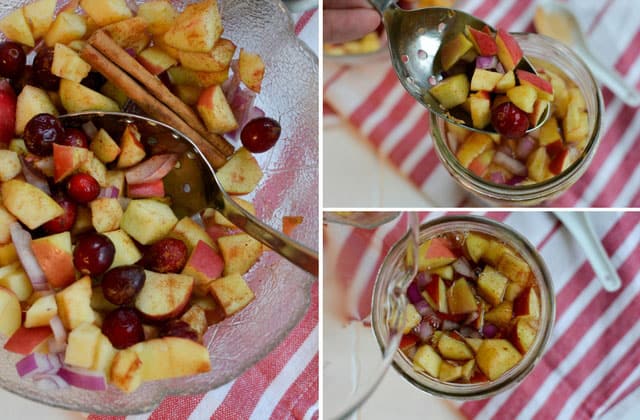
Clockwise from bottom left: Bowl of mixed ingredients. Packing Cranberry Apple Chutney mixture into a jar. Pouring brine over packed chutney mixture.
Ingredients are well mixed and packed into a pint (500 ml) jar. A brine is mixed and poured in to cover the mixture.
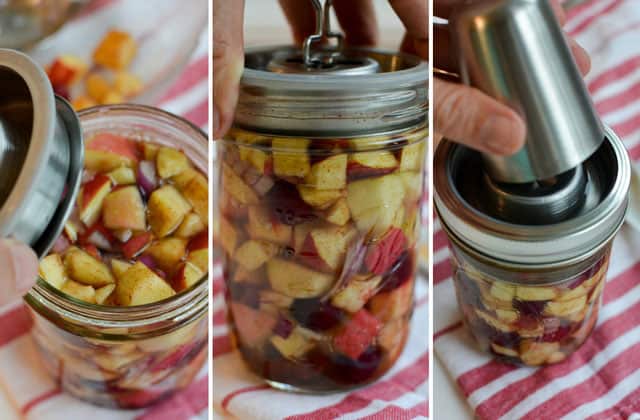
Using the Kraut Source fermentation lid to seal the jar of chutney. Placing the fermentation lid onto the jar. Putting the sealing cap into the Kraut Source fermentation lid water-sealed moat.
Then everything is held below the brine with your choice of fermentation weight and lid. Here I use my Kraut Source Fermentation Lid which I was gifted by Kraut Source for review.
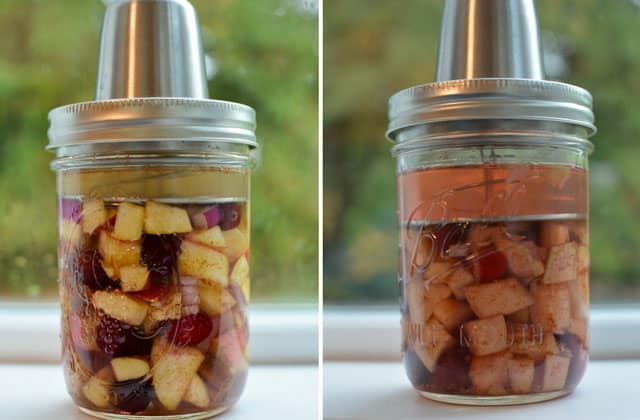
Day one of fermentation for Cranberry Apple Chutney. Day five showing color change and compression of fermentation.
On the left is my jar of freshly prepared Raw Cranberry-Apple Chutney and on the right, what the jar looks like after 5 days of fermentation.
Raw Cranberry-Apple Chutney Recipe
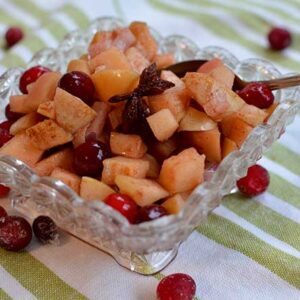
Raw Cranberry-Apple Chutney
EQUIPMENT
- 1 pint (500 ml) wide-mouth canning jar or similar sized jar & lid
- Optional weight and airlock device
INGREDIENTS
- 1/2 cup (120 ml) fresh or frozen cranberries, measure out
- 2 small green apples,, cut into small cubes
- 1/4 cup (60 ml) red onion, finely diced
- 1 star anise pod, (or 1/4 teaspoon anise seeds)
- 1/4 teaspoon (1 ml) cinnamon powder
- 1 cinnamon stick
- 1 2 inch (5 cm) piece of fresh ginger root, finely grated
Brine (2%)
- 1 tablespoon (15 ml) salt dissolved in 2 cups (480 ml) water
INSTRUCTIONS
- CHOP apples and dice onion.
- MIX. Place all ingredients (except brine) in a bowl and mix well.
- PACK the mixed ingredients into a wide-mouth pint (500 ml) jar, to about 1/2 inch below the threads.Gently press the mixture down to compress it.
- BRINE. Pour the brine over the mixture covering the mixture by one inch.
- SUBMERGE. Insert your weight and screw optional airlock lid on. Using tape, label your jar with the date and recipe name.
- FERMENT. Place in a shallow bowl on your kitchen counter, out of direct sunlight to ferment for 5-7 days. Don't let it ferment for too long, or your ferment will shift towards the alcohol side. As it ferments the color dulls. You'll see bubbles rising to the surface during the first few days.
- STORE. When taste is to your liking, add the fermentation length to your label and place in your refrigerator where it can last for up to 6 months.
- ENJOY. Cranberry-Apple Chutney makes for a great winter salad. It may also be served alongside poultry.

Cranberries were originally used to cure meat, heal wounds and dye fabric.
3. Pickled Cranberries
Pickled Cranberries truly are a fun snack food and a great conversation starter at any party.
[su_testimonial name=”Bruce” photo=”https://www.makesauerkraut.com/wp-content/uploads/2015/12/avatar-M1.png”]OMG! I made the pickled cranberries for our thanksgiving bash and they were a raging success! I had only put out a small dish with the cheese plate appetizers thinking it would be too adventurous for most people but I had to keep refilling it over and over as people kept finding me and asking for more. Then I had to put out a large dish with the main meal, too! Delicious![/su_testimonial]
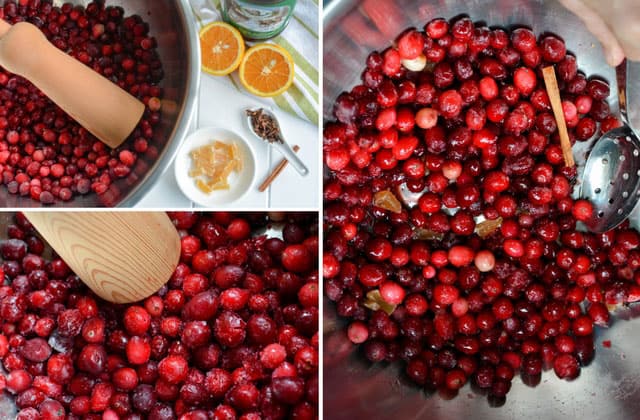
Clockwise from bottom left: Cranberries placed in bowl and mashed to break skins. Rest of ingredients read to add to the crushed cranberries. Cranberries, candied ginger, orange juice, sugar, and spices mixed together.
You’ll want to first pop open some of your cranberries to help along the fermentation process. Place them in a large bowl and gently smash with a potato masher or kraut pounder. Add remaining ingredients and mix well.
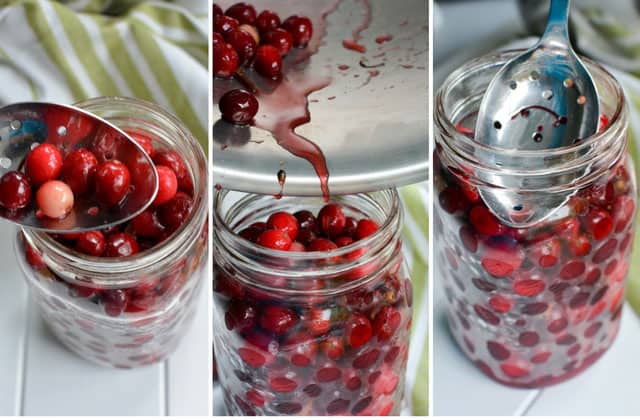
Packing prepared cranberries into a jar. Pouring the last of the berries and juice into the jar. Pressing the cranberries with a spoon to compress them into the jar.
Pack the cranberries into a quart jar pouring in any leftover juice. Gently press the cranberries down to compact them.
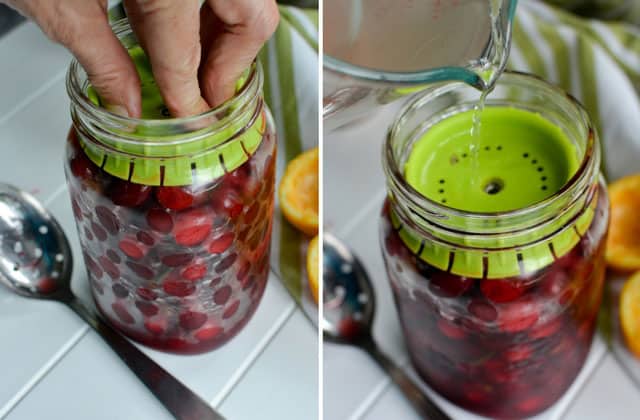
Inserting the Pickle Pusher fermentation weight into the jar. Pouring prepared brine into the jar.
Cranberries are especially floaty – remember those air pockets – so you’ll want some way to hold them below the brine. A cabbage leaf or piece of folded parchment paper can be used to first trap the cranberries and then a small jar, shot glass or clean rock put on top of that. In these pictures, I am using the PicklePusher as reviewed here. More ideas here.
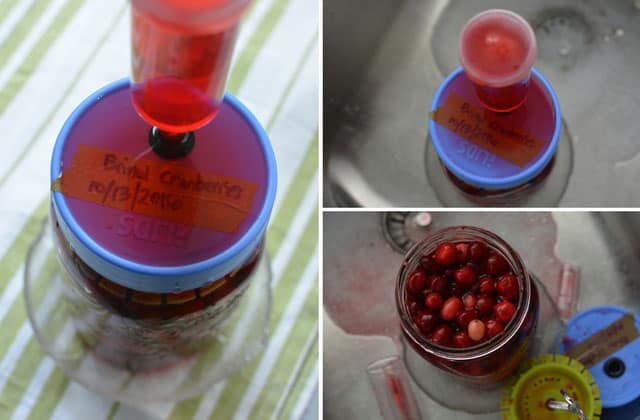
An overactive ferment – and a jar packed too full, perhaps – causes the brine to overflow through the airlock and out of the jar. Moving the jar to the sink to clean up the mess. Removing and rinsing out the airlock.
The cranberries were rather quiet for the first two days, then when I came downstairs on the morning of day 3, I was greeted by the mess shown. Thank goodness I had my jar sitting in a shallow bowl. Everything went into the sink where I popped off the airlock and cleaned things up a bit before repacking the jar so I could continue to let it ferment.
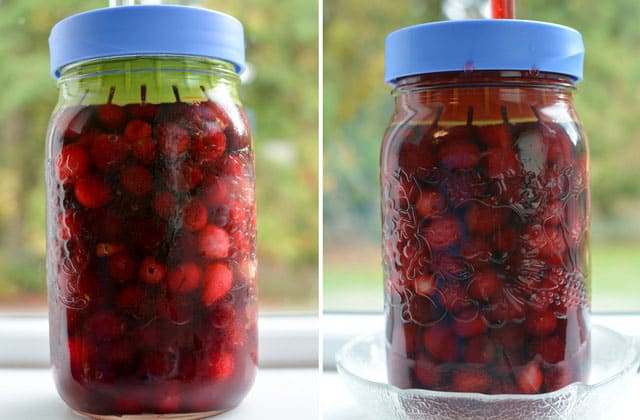
Day one of fermentation for Pickled Cranberries. Day five showing color change and expansion of fermentation.
On the left is my jar of freshly prepared Pickled Cranberries and on the right, what the jar looks like after 5 days of fermentation. As you can see the fermented cranberries are a darker color. You can also see the airlock full of the beautiful rose-colored brine.
Pickled Cranberries Recipe
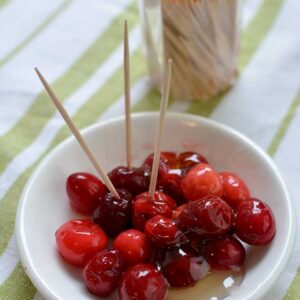
Pickled Cranberries
EQUIPMENT
- 1-quart (L) wide-mouth canning jar or similar sized jar (liter) jar & lid
- Weight and airlock device
INGREDIENTS
- 3 cups fresh or frozen cranberries, measured out; or 12 ounces (340) grams, if weighed
- 1 orange zest of; then juiced
- 4 tablespoons maple syrup
- 3-5 slices of candied ginger,, slivered
- 1 cinnamon stick
- 1 teaspoon whole cloves
Brine (2%)
- 1 tablespoon (15 ml) salt dissolved in 2 cups (480 ml) water
INSTRUCTIONS
- POP BERRIES.Place cranberries in mixing bowl and use a potato masher or kraut pounder to smash the cranberries a bit to break their skins.
- MIX.Add remaining ingredients (except brine) to your bowl and mix well.
- PACK the mixed ingredients into a wide-mouth quart (liter) jar, to about 1/2 inch below the threads. Do not overpack your jar. Once fermentation starts, those little microbes like plenty of space. Gently press the mixture down to compress them.
- BRINE.Pour the brine over the mixture covering the mixture by one inch.
- SUBMERGE.Place your weight and airlock lid on.
- FERMENT.Place in a shallow bowl on your kitchen counter, out of direct sunlight to ferment for 7-21 days.As it ferments the color dulls. You see bubbles rising to the surface during the first few days.
- STORE.When taste is to your liking – they will be a bit sour, add the fermentation length to your label and place in your refrigerator where it can last for up to 6 months. The tart flavor will have mellowed and they will be pleasantly fizzy.
- ENJOY.Serving these at a get together are a fun way to Wow! your guests. For a gorgeous presentation, place in a decorative bowl, then drizzle with a bit of maple syrup or honey. Include some toothpicks for guests to piece one with and then pop into their mouth.

Cranberry plants age well! It’s possible to find 100-year-old vines that are still producing cranberries.
Three ways to fall in love with fermented cranberries: Cranberry-Orange Relish, Raw Cranberry-Apple Chutney, and Pickled Cranberries. Which fermented cranberries recipe will you try?
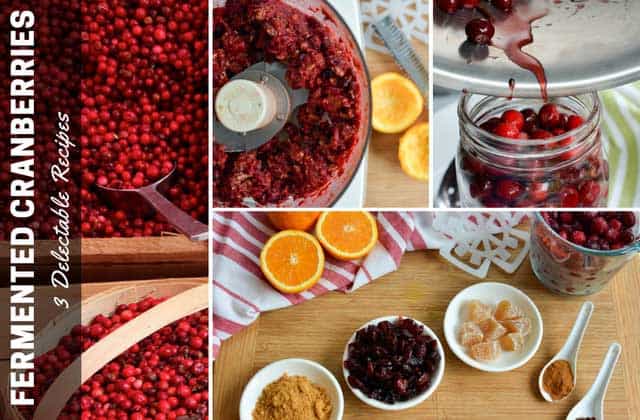
Last update on 2024-07-27 / Affiliate links / Images from Amazon Product Advertising API

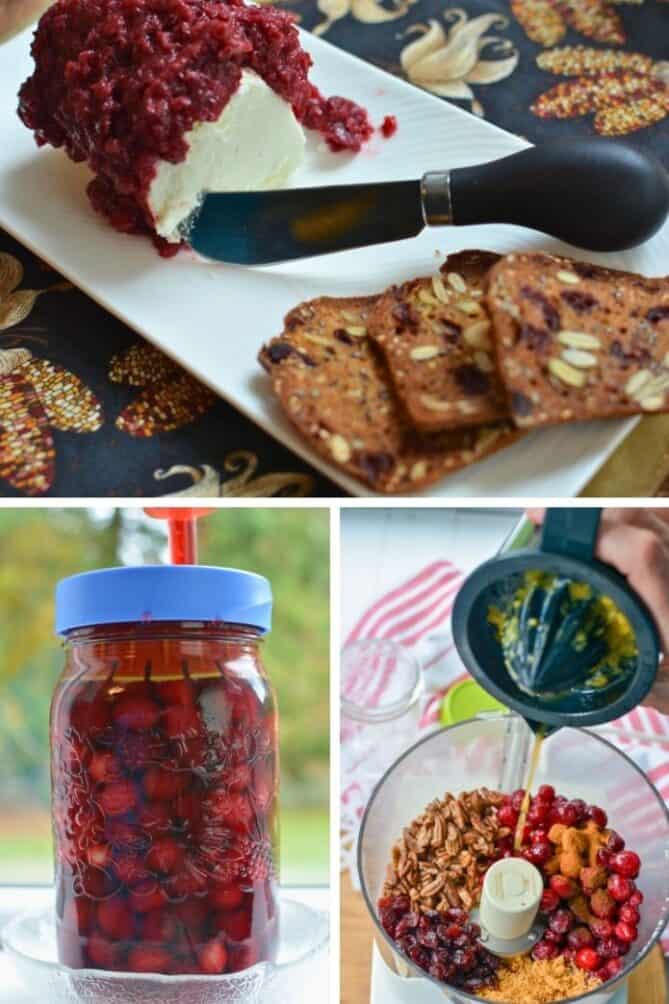

 This post may contain affiliate links which won’t change your price but will share some commission.
This post may contain affiliate links which won’t change your price but will share some commission.